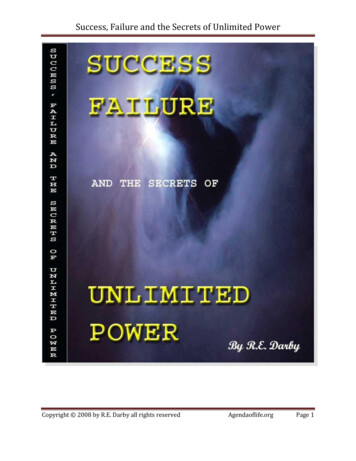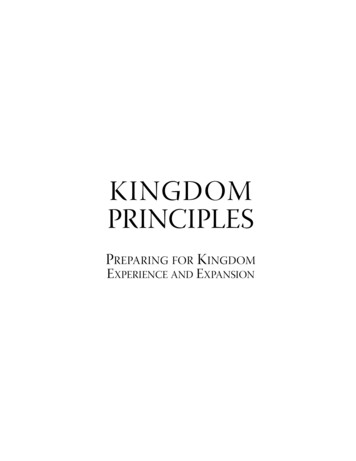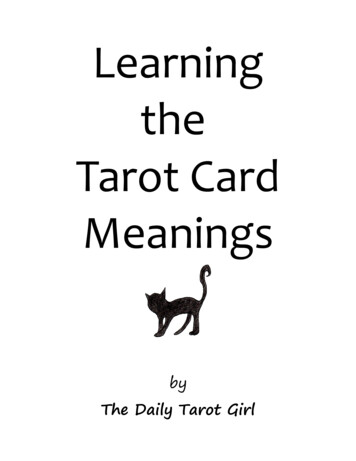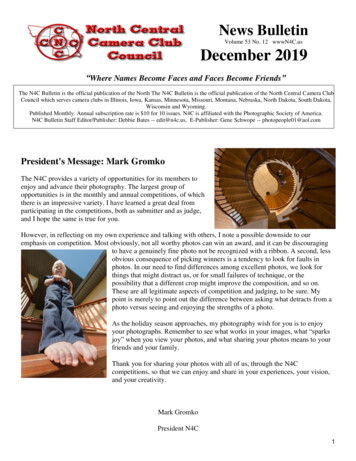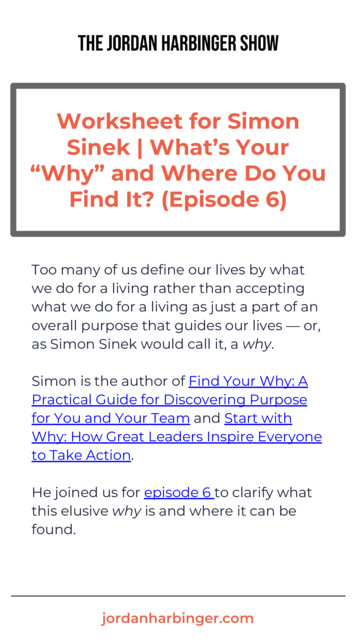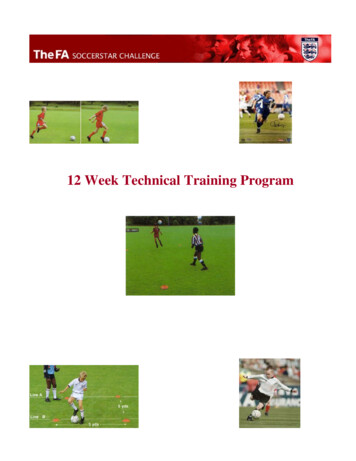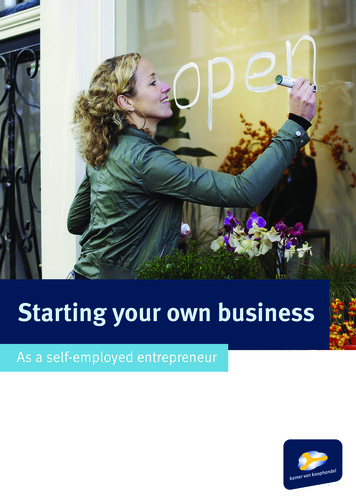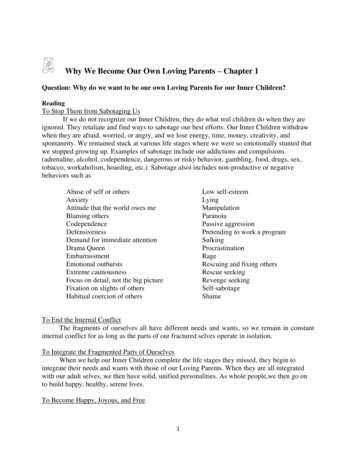
Transcription
Why We Become Our Own Loving Parents – Chapter 1Question: Why do we want to be our own Loving Parents for our Inner Children?ReadingTo Stop Them from Sabotaging UsIf we do not recognize our Inner Children, they do what real children do when they areignored. They retaliate and find ways to sabotage our best efforts. Our Inner Children withdrawwhen they are afraid, worried, or angry, and we lose energy, time, money, creativity, andspontaneity. We remained stuck at various life stages where we were so emotionally stunted thatwe stopped growing up. Examples of sabotage include our addictions and compulsions(adrenaline, alcohol, codependence, dangerous or risky behavior, gambling, food, drugs, sex,tobacco, workaholism, hoarding, etc.). Sabotage alsoi includes non-productive or negativebehaviors such asAbuse of self or othersAnxietyAttitude that the world owes meBlaming othersCodependenceDefensivenessDemand for immediate attentionDrama QueenEmbarrassmentEmotional outburstsExtreme cautiousnessFocus on detail, not the big pictureFixation on slights of othersHabitual coercion of othersLow self-esteemLyingManipulationParanoiaPassive aggressionPretending to work a programSulkingProcrastinationRageRescuing and fixing othersRescue seekingRevenge seekingSelf-sabotageShameTo End the Internal ConflictThe fragments of ourselves all have different needs and wants, so we remain in constantinternal conflict for as long as the parts of our fractured selves operate in isolation.To Integrate the Fragmented Parts of OurselvesWhen we help our Inner Children complete the life stages they missed, they begin tointegrate their needs and wants with those of our Loving Parents. When they are all integratedwith our adult selves, we then have solid, unified personalities. As whole people,we then go onto build happy, healthy, serene lives.To Become Happy, Joyous, and Free1
When our integrated Inner Children feel safe, loved, and respected by us, they provide uswith curiosity, abounding energy, and perfect trust in a Higher Power.2
Exercise - Why We Want to Become Our Own Loving ParentsEach person in the group may share his/her answers on the following questions (or pass).1. How does your Inner Child sabotage you (see the list above)?2. What are your examples of wanting to do different things at the same time or not knowingwhat is the right thing to do?3. Share one need or want of your Inner Child.4. When you were a little child, share one thing you were intensely curious about, one time youwere really excited about something, or one time you had outrageous fun.5. What do you do today that you are intensely curious about, excited about, or is great fun?Things You Can Do in Your Recovery This Week – Why We Become our Own Loving ParentsShare your insights and feelings about this chapter’s information and exercises as well as the activities below withyour sponsor, a program friend, and/or participants at a meeting. Ideally, over time, you will work through all theunresolved issues addressed in this chapter.1. Write your version of this affirmation on a notecard or poster and read it three times a day forone week:I am becoming my own Loving Parentto help my Inner Childgrow up emotionally.2. Fill in the blanks next to the outline of your Inner Child below of what your life will be likewhen you are happy, joyous, and free.Relationship I will be inThings I will doJob I will be doingFun I will haveWhere I will liveFriends who will support me3
What Loving Parents Do; What You Can Do – Chapter 2Question: What do actual loving parents do for their children?ReadingLoving parents provide their children with solid emotional foundations, and nurturehealthy identity development. They love, protect, listen to, appropriately touch, and guide theirchildren gently through the trials and tribulations of growing up. This chapter is an overview ofwhat you can expect in this workbook.A. Loving parents provide their children with strong, solid emotional foundationsIn functional homes, parents automatically provide their children with basic needs of air,food, water, shelter, clothing, and sleep. They provide safety and security. They foster a sense ofbeing loved and belonging in the family, extended family, neighborhood, community, and world.They model how to be trustworthy. They have supportive people around them who give themenergy. They bolster their children’s self-esteem. They support the children’s efforts to explore,learn, grow, and reach the extent of their abilities.ExerciseCircle the things you already do as your own Loving Parent for your Inner Child. For recovery, start doing thethings for your Inner Child that you did not circle.1. Provide basic needs: air, food, water, shelter, clothing, and sleep.2. Ensure safety and security.3. Foster a sense of being loved and belonging in the family, extended family,neighborhood, community, and world.4. Learn to recognize trustworthiness and be trustworthy.5. Gather supportive people around you who give you energy.6. Bolster your Inner Child’s high sense of self-esteem.7. Support your Inner Child’s efforts to explore, learn, grow, and reach the extent of theirabilities.4
B. Loving parents encourage healthy identity developmentGood parents model to their children how to present themselves in the world for success.They model and teach their children healthy core beliefs about hope and trust, will and autonomy,purpose and initiative, competence and industry, fidelity and identity, love and intimacy, caringand pride in accomplishment, as well as wisdom and integrity. They keep their promises.ExerciseCircle the things you already do as your own Loving Parent for your Inner Child. For recovery, start doing thethings for your Inner Child that you did not circle.1. Model how to suit up, show up, listen, participate, and let go of the results.2. Model and teach your Inner Child healthy core beliefs (hope and trust, will and autonomy,purpose and initiative, competence and industry, fidelity and identity, love and intimacy,caring and productivity, and wisdom and integrity).3. Teach your Inner Child how to set limits and enforce boundaries.4. Keep your promises.C. Loving parents show their love in how they communicate with their childrenLoving parents speak to their children gently and respectfully. They guide their childrenthrough the tiny steps of learning new things to ensure success. They cheer their children on tothe next step and applaud their progress. They re-teach by breaking tasks into smaller incrementsso the children will succeed, tell the children how much they admire their efforts, and summarizethe process the children used to do the task. Praise, not punishment and shame, is used toencourage their children. They address misbehavior by pointing out the behavior their childrencan change rather than shaming their children. They immediately and gently provide appropriateconsequences for misbehavior. They teach their children that through honest self-evaluation,planning, hard work, and follow-through, they can accomplish most things. They teach theirchildren to keep a healthy balance each day between work and play.ExerciseCircle the things you already do as your own Loving Parent for your Inner Child. For recovery, start doing thethings for your Inner Child that you did not circle.1.2.3.4.5.6.7.8.Speak to your Inner Child gently and respectfully.Guide your Inner Child through the tiny steps of learning new things, ensuring success.Cheer your Inner Child on to the next step and applaud the progress.Reteach by breaking tasks into smaller increments so your Inner Child will succeed.Praise the efforts of your Inner Child and restate the process of the task.Use praise, not punishment and shame, to encourage your Inner Child.Point out misbehavior your Inner Child can change.Work with your Inner Child to come up with appropriate, immediate consequences formisbehavior by your Inner Child (including an apology, ways to atone, and changes inbehavior).9. Teach your Inner Child that through honest self-evaluation, planning, hard work, andfollow-through, they can usually accomplish most things.10. Teach your Inner Child to keep a healthy balance each day between work and play5
D. Loving parents protect their childrenLoving parents allow their children to freely express themselves and explore, but they areever vigilant to keep their children healthy and safe. Loving parents allow their children to makemistakes, fail, and be disappointed at times.ExerciseCircle the things you already do as your own Loving Parent for your Inner Child. For recovery, start doing thethings for your Inner Child that you did not circle.1. Keep your Inner Child safe as he/she freely expresses him/herself and explores.2. Allow your Inner Child to make mistakes, fail, and be disappointed.E. Loving parents respect their children by listening to themLoving parents make time each day for their children. They focus on and listen to whattheir children need and want from them. They hear the words and tone and read the bodylanguage. They ask their children clarifying questions.ExerciseCircle the things you already do as your own Loving Parent for your Inner Child. For recovery, start doing thethings for your Inner Child that you did not circle.1.2.3.4.Make time to listen to your Inner Child.Focus on and listen to what your Inner Child needs and wants from you.Hear the words and tone and notice the body language of your Inner Child.Ask your Inner Child pertinent questions to clarify your understanding.F. Loving parents appropriately reassure and encourage their children with touchIn their mothers’ wombs, children experience full-body hugging. Upon birth, children areswaddled and lovingly cradled. Their parents look them directly in the eyes and murmur sweetlyto them. As children grow up, appropriate hair tussling, shoulder squeezes, hand-holding, backpats, hugs, and respectful massage (head, face, neck, shoulders, back, hands, and feet) areappropriate. Good parents touch their children with love and respect.ExerciseCircle the things you already do as your own Loving Parent for your Inner Child. For recovery, start doing thethings for your Inner Child that you did not circle.1.2.3.4.5.6.Tussle your Inner Child’s hair.Squeeze his/her shoulder.Hold his/her hand.Pat your Inner Child on the back.Hug your Inner Child.Occasionally massage your Inner Child (head, face, neck, shoulders, back, hands, and feet).6
G. Loving parents guide their children through grievingWhen a beloved person or pet dies, someone moves away, or a child’s hopes have beendashed, loving parents express their feelings in healthy, safe, acceptable, and productive ways.They carefully show and guide their children through the grieving process.ExerciseCircle the things you already do as your own Loving Parent for your Inner Child. For recovery, start doing thethings for your Inner Child that you did not circle.1. Model how to feel and express feelings in safe, acceptable, and productive ways.2. Help your Inner Child work through the process of grieving (denial, anger, bargaining,depression, and acceptance).H. Loving parents raise their children to work through life stages naturallyHealthy families experience disappointments, setbacks, losses, and woes, and good parentsshow their children how to feel, share their feelings, and work through the process of grieving(denial, anger, bargaining, depression, and acceptance). They teach their children to experiencetheir own feelings and express those feelings in acceptable and productive ways.ExerciseCircle the things you already do as your own Loving Parent for your Inner Child. For recovery, start doing thethings for your Inner Child that you did not circle.1. Learn about the stages of emotional development2. Work through unresolved stages of emotional development7
Things You Can Do in Your Recovery This Week – What Loving Parents Do; What You Can DoShare your insights and feelings about this chapter’s information and exercises as well as the activities below withyour sponsor, a program friend, and/or participants at a meeting. Ideally, over time, you will work through all theunresolved issues addressed in this chapter.What is one thing you can do this week in each category below to help your Inner Child?What Loving Parents DoWhat I, as My Own Loving Parent, Will Do for My InnerChild This WeekEnsure child has a solid emotionalfoundationHelp Inner Child find own identityMeet Inner Child’s Needs (Love Me,Protect Me, Hear Me, Hug Me, Heal Me)Model & share own griefComplete incomplete life stages8
Learn to Be Your Own Loving Parent – Chapter 3Question: How can we learn what loving parents do for their children?ReadingIn ACA meetings people shared various methods they have used to learn how to be goodparents to their Inner Children. They took note of how their parents behaved. They used whatwas nurturing, but sometimes did the opposite of what they felt was their parents’ bad behavior.Sometimes they adopted the behavior of good parents modeled in movies and on television.Sometimes they saw examples of good and bad parenting in public places and may have adoptedthe healthy behaviors. Sometimes they read books about healthy parenting and took parentingclasses.Exercise - What’s Your Story?Briefly share what you have learned about good parenting.1. Watching how my parents behaved and adopting what I thought was right2. Watching how my parents behaved and adopting what I thought was wrong3. Seeing parenting in movies and on television shows4. Emulating parents of friends and relatives5. Seeing good parenting behavior in public places6. Reading parenting books7. Taking parenting classes9
Things You Can Do in Your Recovery This Week – Learn to Be Your Own Loving ParentShare your insights and feelings about this chapter’s information and exercises as well as the activities below withyour sponsor, a program friend, and/or participants at a meeting. Ideally, over time, you will work through all theunresolved issues addressed in this chapter.What is one Your Responses1. Example of good parentingby your Mom or Dad?2. Example of parenting byMom or Dad you will not useraising your child(ren)?3. Example of good parentingseen on TV or in a movie?4. Example of good parentingyou saw from someone’sparent growing up?5. Example of good parentingyou saw in a public place?6. Title and author of oneparenting book and whereyou can get it?7. Agency, address, & phone #where you can enroll for aclass on ne:Date & time of first class:10
Learn to Recognize & Communicate with My Inner Child – Chapter 4Question: How can I recognize and communicate with my Inner Child?ReadingOur Inner Children emerge when we experience traumas that are too overwhelming for usto emotionally process. Emotionally we fragment or compartmentalize parts of our personality.Without parental modeling, instruction, tools, or support to work through the events that wethought would seriously harm us or someone we loved, we become emotionally stunted.We may block out the traumatic events and forget them, but they still are recorded in ourunconscious mind. They rise up automatically and immediately when similar things happen inour lives. Listed in the exercise below are some ways we have contact with our Inner Children.Exercise - Ways I Recognize , Communicate With, and Connect With My Inner Child(ren)In the interests of time, allow only one person to share per topic on his/her experience with his/her Inner Child.1.Activities / play / toys ofchildren7.Recognizing our own childlikebehavior13. Experiencing strong feelings (anger,joy, fear )2.Daily writing or journaling8.Rages and tantrums14. Triggered memories3.Drawing with crayons (or otherart forms)9.Role play Loving Parent &Inner Child conversation15. Visualization / Guided Meditation4.Non-dominant handwriting10. Self-meditation16. Unusual or illogical behavior5.Photos of ourselves aschildren17. Wants, urges, and yens6.Procrastination or inability tomake decisions or act11. Positive sensory stimulants –visual, auditory, taste, smell,touch12. Spontaneous, playful activityThese are techniques you can use in recovery to connect with your Inner Child.1118. Withdrawing, isolating, and beingdepressed
Things You Can Do in Your Recovery This Week - Recognize & Communicate with My Inner ChildShare your insights and feelings about this chapter’s information and exercises as well as the activities below withyour sponsor, a program friend, and/or participants at a meeting. Ideally, over time, you will work through all theunresolved issues addressed in this chapter.Put an X on each way you connect with your Inner Child during the week:Activities – do children’sactivities or adult versions ofthem – parties, play days,sports, gardening,building Gut Punch - Write downtroubling incidents youencounter this week, yourfeelings, & how you reactedSensory Auditory - Whatpleasant things did you hearthis week? What memorydid you recall?Sensory Visual - Whatpleasant things did you seethis week? What memorydid you recall?Wants, Yens, & Urges –What unrelenting desiresarose? What did you do?What might have evokedthem?Art - Create art (draw, paint,sculpt, craft )Meditation / Visualization– meditate about orvisualize your Loving Parenttalking with your Inner ChildSensory Smell - Whatpleasant aromas/scents didyou smell this week? Whatmemory did you recall?Talk Each Morning - Set atime for each and everymorning to talk to your InnerChild for 10 minutes. Whattime did you set? How manymornings did you keep yourcommitment?Weird Behavior – Whendid you act in ways youfound odd or strange? Whathappened just before that?Childhood Photo -Talk tothe child in a photo ofyourself as a small childMired – note times youcannot get yourself to dosomething or you putsomething offTalk Each Night - Set atime for each and everyevening to talk to your InnerChild for 10 minutes. Whattime did you set? How manyevenings did you keep yourpromise?Withdraw or Isolate –When did you withdraw orisolate this week? Whattriggered your reaction?Dance - Move to musicReacting – note one timeyou acted out like a mad,hurt, or fearful child andwhat triggered thatSensory Taste - Whatpleasant things did youtaste this week? Whatmemory did you recall?Talk Throughout the Day– When you suddenly feelangry. afraid, sad,confused,or stunned, talk briefly talkwith your Inner Child tocalm him/her, resumeactivity, and thoroughlydiscuss it during eveningtalk.Write - Write notes to yourInner Child with yourdominant hand; answer asyour Injner Child by writingwith your non-dominanthandGame – play child’s gameor adult version of itRun, Jump, Laugh, Wiggle- When did you act silly,loose, and carefree thisweek?Sensory Touch - Whatpleasant touch did youreceive from someone thisweek? What memory didyou recall?Toys – play with child’s toyor adult version of itWrite - Write poem, story,or song12
Meet Your Inner Child Visualization – Chapter 5Question: How can you meet your Inner Child?ReadingVisualization is a helpful tool that gives participants actual images of their tiny InnerChildren. That image allows us to more readily accept the Loving Parent-Inner Child idea.Some of us have found that when we actually meet our Inner Children, they are wary ofus. This is understandable. Once we were adults, we continued to surround ourselves with peoplewho mistreated us as our parents and caretakers had. Worse, we mistreated ourselves. Our InnerChildren know that and do not trust us.When we began our Inner Child work, some of our Inner Children did nothing, waiting tosee if the abuse would finally stop. They were willing to give us a chance. All our Inner Childrenreally want is our love, our attention, and our commitment to stop the insanity. Others releasetheir pent-up rage, much like a real three-year-old who screams, “I hate you! I want to kill you.”Their frustration with us is understandable. In the end what they REALLY want from us is love,protection, true attention, and guidance to grow up emotionally so they can live happy, healthy,functional lives.Exercise - Meeting Your Inner Child Through VisualizationAs someone reads the narrative for the visualization, you may choose to participate or not. If at any time you beginto feel uncomfortable, you may stop participating, too. A program person has been designated to talk you throughyour discomfort. If you continue feeling discomfort after this experience, you may want to get professional help froma counselor or therapist.13
VisualizationWe are going to do some guided imagery so you can meet your Inner Child today. Seatyourself comfortably. Sit up straight. Relax your arms. Uncross your legs, and put your feet flaton the floor. Relax.Close your eyes now. Inhale slowly and notice how you are breathing. Inhale; exhaleslowly. Inhale deeply; exhale slowly. Feel your breathing coming from the bottom of your lungs.Breathe in and breathe out slowly and evenly. Breathe in; breathe out. Breathe in; breathe out.Today you are going to explore a cavern not far away. It is a beautiful, sunny day withblue skies and white, puffy clouds. It’s not too warm, and it’s not too cool. A gentle breezecaresses your face. You hear birds chirping. As you walk along the path toward the cavern, yousee butterflies flitting near the wild flowers and lush, green grass. You see brown squirrelschasing each other up and down a huge oak tree as you pass.You walk up and down the gentle slopes of the path. You come to the entrance of a cave.As you walk forward and descend into the cave, the tunnel opens up into a subterranean room.Light reflects from an iridescent pool casting beautiful, translucent, dancing silhouettes on thecavern walls.You make your way to the pool on the cavern floor. As you approach the pool, you see alittle child perched on the other side of it dangling his or her feet into the water. When you stop,you notice what the child looks like, how the child is dressed, how old this child is, and thechild’s facial expression and body language.You inadvertently kick a stone with your foot. The little child looks up toward the noiseand sees you. The child watches as you approach your side of the pool.You smile and wave to the child. You say hello and tell the child your name. You waitfor the child to respond. You notice how the child behaves toward you. You tell this child youare happy to meet him or her. You ask this child how he or she feels about meeting you. You tellthe child how happy you are to see him or her.Then you ask, “Is there anything can I do for youright now?” You wait for an answer and respond to the child.Then you tell the child that you need to leave but promise that you will talk again, soonand often. You listen to the child’s response, say goodbye, turn, and walk across the cavern floor.Reaching the stairway, you turn back, wave to the child, and climb up the stairs out of the cave.You emerge into the world of dancing butterflies and brown squirrels chasing one another.When you are ready, open your eyes.14
DebriefingPair up with a partner. Both partners address each question before going on to the next question. You have tenminutes to discuss these 5 questions.1. How do you feel right now?2. What feelings came up when you saw your Inner Child?3. What happened when you talked with your Inner Child? How do you feel about that?4. Did you set up a time, date, and place to meet again?5. What do you want to tell your Inner Child the next time you meet?Things You Can Do in Your Recovery This Week - Inner Child VisualizationShare your insights and feelings about this chapter’s information and exercises as well as the activities below withyour sponsor, a program friend, and/or participants at a meeting. Ideally, over time, you will work through all theunresolved issues addressed in this chapter.1.Talk Each Morning - Set up a time each morning and meet with your Inner Child.Tell him/her how much you love him/her. Talk about what is expected to happen. Discussfeelings about that. Consider ways to be most effective.2.Talk Each Night - Set up a consistent time each evening and talk with your InnerChild about your experiences throughout the day, how your Inner Child felt about them, whatyour Inner Child is proud of, and what your Inner Child wants to do better if a similarsituation arises.15
What Does Your Inner Child Want From You? – Chapter 6Question: How Can You Prove to your Inner Child you will Finally Be a Loving Parent?ReadingIf we ask our Inner Children what they want from us, each one will give us some variationof: “Love me, protect me, hear me, hug me, and heal me.”Exercise - What Your Inner Child Wants From YouTake a few minutes to fill in the chart below and then go around the room and share on each topic.My Inner Child Tells MeHow are you showing this toyour Inner Child?Circle those that you are already doingSHOW YOUR LOVELove MeSchedule time to communicate dailyPlan to play dailyIn a mirror tell your Inner Child you lovehim/herPraise and reward good behavior give Providesomething he/she wantsPROTECT YOUR INNER CHILDRemove unsafe people, places, and things Stand upfor yourself and your Inner Child Set strong limits andenforce boundariesProtect MeLISTEN TO YOUR INNER CHILDHear MeCommunicate every morning and nightAsk questions and listen to the answersNote your strong reactionsBe aware pf pumping adrenalineNotice numbnessBe aware of feeling coldNotice symptoms of shockHUG YOUR INNER CHILDHug MeOffer to hug someone each dayAccept hugs from safe peopleGet a massageHug yourself, pillows, stuffed animals, and petsPet animals in pettng zoosGive service in programsVolunteer in your communityDesignate a home meeting.Get a support systemHEAL YOUR INNER CHILDBuild a solid emotional foundationDefine your identityGrieve your lossesComplete life stages not yet completedHeal Me16What is one thing you will doto reassure your Inner Child?
Things You Can Do in Your Recovery This Week - What Your Inner Child Wants From YouShare your insights and feelings about this chapter’s information and exercises as well as the activities below withyour sponsor, a program friend, and/or participants at a meeting. Ideally, over time, you will work through all theunresolved issues addressed in this chapter.Fill in the last column with one thing you will do this week to meet each of your Inner Child’s needs.My Inner Child Needs From MeThis Week for my Inner ChildSHOW YOUR LOVESchedule time to communicate dailyPlan to play dailyIn a mirror tell your Inner Child you lovehim/herPraise and reward good behavior giveProvide something he/she wantsPROTECT YOUR INNER CHILDRemove unsafe people, places, and thingsStand up for yourself and your Inner ChildSet strong limits and enforce boundariesLISTEN TO YOUR INNER CHILDCommunicate every morning and nightAsk questions and listen to the answersNote your strong reactionsBe aware pf pumping adrenalineNotice numbnessBe aware of feeling coldNotice symptoms of shockHUG YOUR INNER CHILDOffer to hug someone each dayAccept hugs from safe peopleGet a massageHug yourself, pillows, stuffed animals, andpetsPet animals in pettng zoosGive service in programsVolunteer in your communityDesignate a home meeting.Get a support systemHEAL YOUR INNER CHILDBuild a solid emotional foundationDefine your identityGrieve your lossesComplete life stages not yet completed17
Building a Relationship with Your Inner Child – Trust – Chapter 7Question: How can you build trust with your Inner Child?ReadingOur Inner Children, like flesh-and-blood people, assess what we say and do to them andothers. They have been quietly watching us for years. They know when we allowed others toabuse them. They know when we have abused them.We know what they want from us as their loving parents. They want to be loved,protected, heard, reassured physically of our love, and guided to grow up emotionally into happy,healthy adults. Our job in recovery is to become the loving parents they want who will do thosethings.To that end, our first job is to actively, daily, work to become trustworthy. Trust dependson communicating clearly, being reliable, being respectful and sincere, being honest, beingconsistent, keeping commitments we make, and being competent.Communicate ClearlyOne way some of us survived in our dysfunctional homes was to respond to parents andcaretakers without actually saying anything that could get us in trouble. We learned to mumble.We learned to obfuscate. We gave “answers” that did not have any bearing on the questions wewere asked, or we changed the subject. We learned quickly not to take a moral position orventure any definitive viewpoint that could be used as evidence against us. In recovery, we learnto clearly say what we mean and mean what we say.Be ReliableWe could not depend on our parents or caretakers in our childhood homes. In programrecovery, we become people others can depend on.We regularly show up on time, suitablydressed, with the knowledge, experience, and tools to do the tasks we are given. We do the tasksefficiently and effectively in a timely manner.Be RespectfulDysfunctional people with deep-rooted, unresolved anger are sometimes disrespectful.This often warns others to leave them alone or suffer the consequences. In program recovery, welearn to treat ourselves and others with respect. We trace our anger back to its childhood roots,then we grieve our losses. We reparent ourselves to make certain that the words we say are fromour hearts.Be Honest and SincereGrowing up, we often heard parents and caretakers fibbing, telling half-truths, omittingimportant information, and outright lying to us, one another, and others. They said one thing, butdid another. They cheated. They stole. They blamed others for what they did. Some of usadopted those family rules. In recovery, we challenge our sense of superiority as well as our18
inferio
Loving parents allow their children to freely express themselves and explore, but they are ever vigilant to keep their children healthy and safe. Loving parents allow their children to make mistakes, fail, and be disappointed at times. Exercise Circle the things you already do as your
![[Page 1 – front cover] [Show cover CLEAN GET- AWAY 978-1 .](/img/13/9781984892973-6648.jpg)
